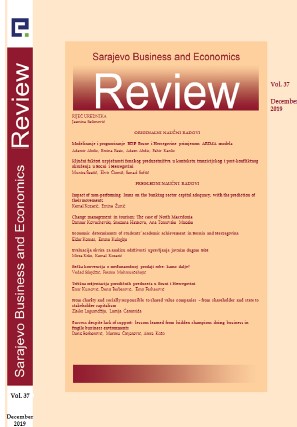SHARE OF ADULTS WHO ORDER GOODS OR SERVICES ONLINE INFLUENCED BY SHARE OF THOSE WITH DIGITAL SKILLS BROKEN DOWN BY GENDER: CLUSTER ANALYSIS ACROSS EUROPEAN COUNTRIES
SHARE OF ADULTS WHO ORDER GOODS OR SERVICES ONLINE INFLUENCED BY SHARE OF THOSE WITH DIGITAL SKILLS BROKEN DOWN BY GENDER: CLUSTER ANALYSIS ACROSS EUROPEAN COUNTRIES
Author(s): Ksenija Dumičić, Blagica Novkovska, Emina ResićSubject(s): Gender Studies, Education, Business Economy / Management, Demography and human biology, Transformation Period (1990 - 2010), Present Times (2010 - today), ICT Information and Communications Technologies
Published by: Ekonomski fakultet u Sarajevu
Keywords: purchasing goods and services online; digital skills; liner regression model; regression diagnostics; hierarchical cluster analysis;
Summary/Abstract: This paper investigates the influence of digital skills of females and males on the percentage of individuals ordering goods or services online in selected European countries. In EU28, from 2007 to 2018, this percentage has been linearly increasing by 2.8 percentage points annually, being doubled from 30% to 60%, and based on the linear trend extrapolation forecast, it would reach 65% in 2020. In 2017, the percentage of such Internet users ranged from 13%, for Montenegro, to 82%, for United Kingdom, with the overall average of 48% per country. Just to focus the EU candidates, other than Montenegro, which has the minimum value of the indicator considered, North Macedonia has 15%, Serbia 31% and Turkey reached 21%, and they joined the cluster with Romania Bulgaria, Greece and Croatia. The correlations of percentage of females and males having basic or above basic digital skills with the main variable under study were analysed, and the positive correlation appeared to be slightly stronger for female, than for male. Clustering of countries appeared to be different when using the variable showing basic or above basic digital skills for females or males, showing in Slovenia surprisingly visible shift from the less, in 2007, to the most developed clusters of countries, in 2017, when using the females’ data. This result might be used in improving selling approaches and techniques, with perspective to improve business results and customer satisfaction, and might be useful for creators of education policies across not enough developed countries, to influence a digital skills adoption increase over both gender.
Journal: Zbornik radova - Sarajevo Business and Economics Review (SBER)
- Issue Year: 2020
- Issue No: 38
- Page Range: 97-114
- Page Count: 18
- Language: English

